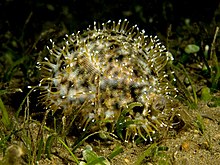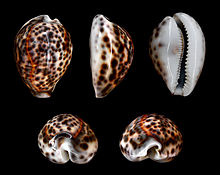Cypraea tigris
| Cypraea tigris | |
|---|---|

| |
| Anterior view of a live individual of Cypraea tigris with its mantle fully extended | |

| |
| Five views of a shell of Cypraea tigris | |
| Scientific classification | |
| Kingdom: | Animalia |
| Phylum: | |
| Class: | |
| (unranked): | |
| Superfamily: | |
| Family: | |
| Subfamily: | |
| Genus: | |
| Species: | C. tigris
|
| Binomial name | |
| Cypraea tigris | |
| Synonyms[2] | |
| |
Cypraea tigris, commonly
Taxonomy

The tiger cowry was one of the many species originally described by Carl Linnaeus in his 1758 10th edition of Systema Naturae, and the species still bears its original name of Cypraea tigris.[1] Its specific epithet tigris relates to its common name "tiger" (the shell however is spotted, not striped). This species is the type species of the genus Cypraea.
Subspecies and forms
- Cypraea tigris form incana Sulliotti, G.R., 1924[3]
- Cypraea tigris form lyncicrosa Steadman, W.R. & B.C. Cotton, 1943[4]
- Cypraea tigris var. schilderiana Cate, C.N., 1961
- Cypraea tigris form tuberculifera Sulliotti, G.R., 1924[8]
Description

Roughly egg-shaped and dextral, the glossy shell is large and heavy for a cowry. It measures up to 15 cm (6 in) in length, and the upper or dorsal side is white, pale bluish-white, or buff, densely covered with dark brown or blackish barely circular spots. Akin to many other Cypraea snails, the shells surface is notably effulgent, as if it were deliberately polished. There is sometimes a blurred red line along the length of the shell at the midline on the dorsal surface. The lower margins are rounded (that is, there is no sharp margin between the upper and lower surfaces of the shell as is found in some other cowries). The ventral side is white or whitish, and the shell opening is lined with tooth-like serrations.[9]
As is the case in almost all cypraeids, two lateral extensions of the mantle are able to extend so as to cover the shell completely, meeting at the midline of the dorsal surface. The mantle can also withdraw into the shell opening when threatened. In this species, the exterior surface of the mantle has numerous pin-like projections that are white-tipped.
Distribution and habitat
The tiger cowrie is found on the ocean floor in the
This species is endangered in Singapore.[10]
Diet
The
Human use

Despite the fact that this species does not occur in the
The shells of this species of cowry are still popular among shell collectors, and are also used as a decorative object, even in modern times.
The shell of Cypraea tigris is believed to help to facilitate childbirth: some women in Japan hold a shell of this species during childbirth.[citation needed]
Large cowry shells such as that of this species were used in Europe in the recent past as a frame over which sock heels were stretched for darning, i.e. instead of using a darning egg. The cowry's smooth surface allows the darning needle to be positioned under the cloth more easily than when using a darning mushroom made of wood.[citation needed]
Gallery
-
A live individual of Cypraea tigris viewed from the posterior end; note the mantle partly covering the shell.
-
Cypraea tigris with mantle partly extended.
-
A living individual of Cypraea tigris
-
Closeup look of Cypraea tigris and its mantle with projections.
-
Drawing of a right-side view of the shell of Cypraea tigris from Index Testarum Conchyliorum (1742) by Niccolò Gualtieri.
-
Drawing of the ventral view of a shell of Cypraea tigris from Index Testarum Conchyliorum (1742) by Niccolò Gualtieri.
-
Drawing of the animal and the shell of Cypraea tigris; a) the shell b) the mantle c) foot d) siphon e) proboscis f) tentacles
See also
References
- ^ Systema naturaeper regna tria naturae, secundum classes, ordines, genera, species, cum characteribus, differentiis, synonymis, locis. Tomus I. Editio decima, reformata (in Latin). Holmiae. (Laurentii Salvii). p. 211.
- ^ "Cypraea tigris". Gastropods.com. Retrieved 21 October 2010.
- ^ "Cypraea tigris incana". Gastropods.com. Retrieved 21 October 2010.
- ^ "Cypraea tigris lyncicrosa". Gastropods.com. Retrieved 21 October 2010.
- ^ "Cypraea tigris schilderiana". Gastropods.com. Retrieved 21 October 2010.
- ^ Foin, T. C. (1972). "Ecological influence on the size of Cypraea tigris L., 1758, in the Pacific". Journal of Molluscan Studies. 40 (3): 211. Archived from the original on 15 April 2013.
- ^ Kay E. A. 1961. On Cypraea tigris schilderiana Cate. The Veliger 4: 36–40
- ^ "Cypraea tigris tuberculifera". Gastropods.com. Retrieved 21 October 2010.
- ^ ]
- ^ a b (file created 1 April) 2009. Singapore Red Data Book 2008 Archived 31 March 2010 at the Wayback Machine. Retrieved 6 September 2009.
- S2CID 225395616.
- ^ Grabowski, Marcie (19 August 2020). "Native Hawaiian sea snails eat invasive sponge | University of Hawaiʻi System News". University of Hawaiʻi System News. Retrieved 8 November 2020.
- ISBN 0-521-80054-4.
External links
- On-line articles with Cypraea tigris in the HAWAIIAN SHELL NEWS (1960-1994)
- OBIS Indo-Pacific Molluscan Database
- Photos of specimens of Cypraea tigris by Smithsonian National Museum of Natural History
- Photo of Cypraea tigris schilderiana by Smithsonian National Museum of Natural History
- Photos of Cypraea tigris on Sealife Collection







